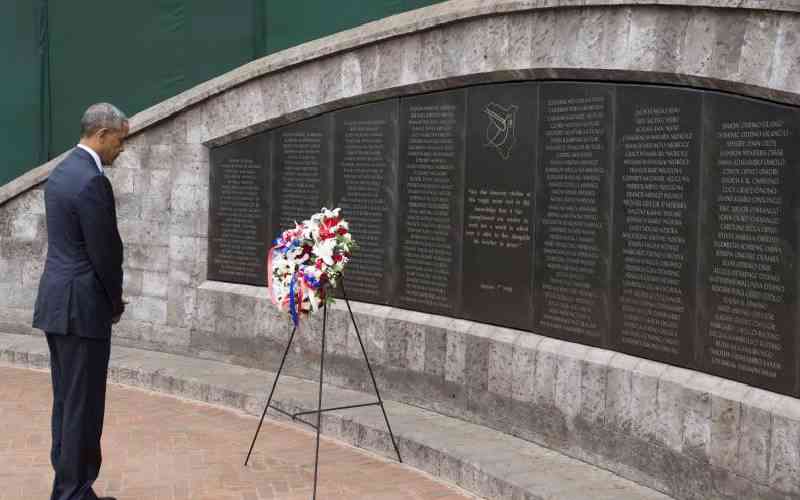By Joe Kiarie
At 10.30am on August 7, 1998, gunshots and a light explosion believed to be that of a flash grenade attracted the attention of curious onlookers outside the US Embassy in Nairobi.
Minutes later, as bystanders in the vicinity dallied or rushed to the scene to establish what was unfolding, a monster bomb detonated claiming more than 200 lives and injuring more than 4,000 people.
By failing to lie down or take cover upon hearing the initial blast, a sizeable number of onlookers ended up as victims of the terrorist attack, curiosity proving to be their undoing.
Secondary attacks
Fast-forward to 2012 and the explosion that rocked Nairobi last Monday proved Kenyans are yet to pick vital lessons from disasters. With the cause of the explosion yet to be established and the area still unsecured, thousands of civilians, among them top politicians, jammed Moi Avenue.
From rescuing the victims to observing, taking photos, looting, and scoring cheap political points, the agendas were varied. In between the two episodes, hundreds of civilians have perished after rushing to accident scenes, mainly those involving overturned fuel tankers.
But security experts are now making a frantic plea to Kenyans to stop this trend, particularly during an explosion, saying it could soon turn catastrophic with the ever-rising possibility of a secondary bomb.
Emergency response experts on their part caution the jamming of crime scenes not only endangers the survival chances of victims but also the health of bystanders.
Captain (Rtd) Simiyu Werunga, a security expert, warns with the current trend of explosions in the country, chances of more devastating secondary attacks are rising as terrorists could capitalise on the predictable crowd reaction. “Our top leaders and civilians are exposing themselves to untold dangers. The terrorists have now upgraded from grenades to improvised explosive devices and we have seen how destructive they can be.
They understand the human psychology and with the surging of crowds, they could try to claim more casualties by using secondary bombs,” he states.
Werunga notes as much as people have to show emotions and rescue victims, they should only do so after experts comb the vicinity and confirm there are no more explosives around. “Even if it is the Prime Minister, let him wait until he is given a go ahead,” he advises, terming the jamming of crime scenes by civilians as a national psychological problem.
Critical evidence
Other than endanger their lives, the expert says the uncontrolled jamming of such scenes neutralises critical evidence.
“Anybody at the scene certainly tampers with forensic evidence. No matter who you are, don’t go to the scene unless under a guided tour by trained personnel to avoid tampering with evidence,” he states.
Stay informed. Subscribe to our newsletter
Others to express give similar warnings are CID boss Ndegwa Muhoro and Internal Security Assistant minister Orwa Ojodeh, who was himself at the explosion scene on Monday. Lt Col (rtd) Clive Lee, the G4S General Manager, Fire Protection and Safety Solutions, admits it is time Kenyans wake up to the reality of the peril they are exposing themselves to.
“A secondary blast always claims much more casualties and is usually a possibility. It is terrorist procedure to have a blast, attract people and launch a major blast. It is shocking to see politicians seeking votes while civilians take photos at explosion scenes. This is very dangerous and must stop,” he affirms.
Lee laments civilians have been lowering the survival chances of victims by frustratingly obstructing emergency response vehicles and by handling casualties unprofessionally.
He blames the state’s emergency response system of delayed arrivals at accident scenes and says a disaster management strategy must be put in place immediately an accident occurs.
Fire fighters
“The police should first have a cordon far away from the affected area and crowds should keep off and allow emergency services to carry out their mandate,” the manager advises, calling for emergency drills to be conducted frequently as a way to prepare for such eventualities.
Mr Boniface Ruto, a senior fire officer at KK Security’s fire department, says civil disturbance has proved to be a perennial bottleneck during emergencies. He recounts numerous occurrences when firefighters from the firm have had to plead with adamant bystanders to give way for fire trucks.
“While some just block the entry to the scene in an attempt to define what is happening, others try to do what we are doing as they think they can do it better and we have to plead with them to step aside,” he explains.
Ruto says others deliberately lock out firefighters so that they can loot and gives an example of an incident in which, despite arriving on time, firefighters were stoned and kept away by looters taking advantage of a fire breakout.
The officer-cum-trainer concurs the possibility of secondary bombs is now real and urges for caution.
People behaviour
“Terrorists worldwide understand people’s behaviour and psychology and at times tend to use two bombs, the first as bait. It attracts attention while the second is meant to claim more casualties from onlookers and rescuers,” he says.
Ruto urges for extensive sensitisation of Kenyans on disaster response.
“In case of an explosion, run as fast and as far as you can from the scene. If you are at the scene, go down on your belly to minimise injuries from projectors. If fire comes to you, crawl away towards the outside wall if possible,” he instructs.
Werunga asserts that with Kenyans reluctant to learn, it is now incumbent upon security organs to seek novel ways to move in fast and cordon crime scenes before crowds pile up.
“Let’s go back to the disaster management programme and ensure the area is cordoned off as fast as possible. Let’s utilise the resources we have on the ground, including private guards, to seal off the area before other trained personnel come in,” he advises.
 The Standard Group Plc is a
multi-media organization with investments in media platforms spanning newspaper
print operations, television, radio broadcasting, digital and online services. The
Standard Group is recognized as a leading multi-media house in Kenya with a key
influence in matters of national and international interest.
The Standard Group Plc is a
multi-media organization with investments in media platforms spanning newspaper
print operations, television, radio broadcasting, digital and online services. The
Standard Group is recognized as a leading multi-media house in Kenya with a key
influence in matters of national and international interest.
 The Standard Group Plc is a
multi-media organization with investments in media platforms spanning newspaper
print operations, television, radio broadcasting, digital and online services. The
Standard Group is recognized as a leading multi-media house in Kenya with a key
influence in matters of national and international interest.
The Standard Group Plc is a
multi-media organization with investments in media platforms spanning newspaper
print operations, television, radio broadcasting, digital and online services. The
Standard Group is recognized as a leading multi-media house in Kenya with a key
influence in matters of national and international interest.







